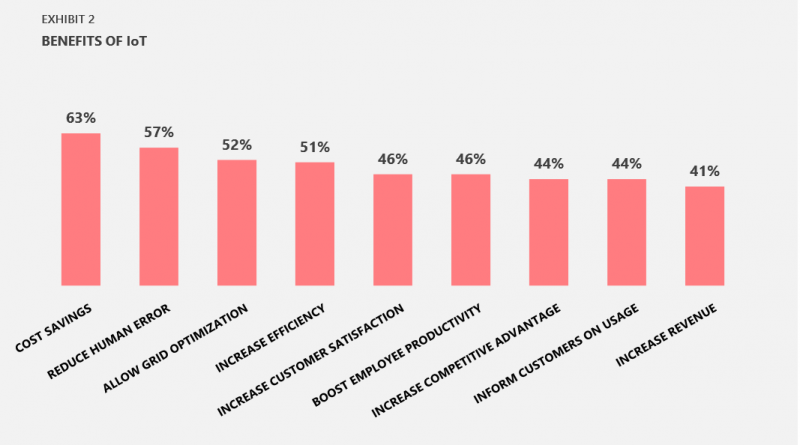IoT Signals energy report: Embracing transparent, affordable, and sustainable energy
The increased use of renewables, resiliency challenges, and sustainability concerns are all disrupting the energy industry today. New technologies are accelerating the way we source, store, and distribute energy. With IoT, we can gain new insights about the physical world that enables us to optimize and create more efficient processes, reduce energy waste, and track specific consumption. This is a great opportunity for IoT to support power and utilities (P&U) companies across grid assets, electric vehicles, energy optimization, load balancing, and emissions monitoring.
We've recently published a new IoT Signals report focused on the P&U industry. The report provides an industry pulse on the state of IoT adoption to help inform us how to better serve our partners and customers, as well as help energy companies develop their own IoT strategies. We surveyed global decision-makers in P&U organizations to deliver an industry-level view of the IoT ecosystem, including adoption rates, related technology trends, challenges, and benefits of IoT.
The study found that while IoT is almost universally adopted in P&U, it comes with complexity. Companies are commonly deploying IoT to improve the efficiency of operations and employee productivity, but can be challenged by skills and knowledge shortages, privacy and security concerns, and timing and deployment issues. To summarize the findings:
Top priorities and use cases for IoT in power and utilities
- Optimizing processes through automation is critical for P&U IoT use. Top IoT uses cases in P&U include automation-heavy processes such as smart grid automation, energy optimization and load balancing, smart metering, and predictive load forecasting. In support of this, artificial intelligence (AI) is often a component of energy IoT solutions, and they are often budgeted together. Almost all adopters have either already integrated AI into an IoT solution or are considering integration.
- Using IoT to improve both data security and employee safety is a top priority. Almost half of decision-makers we talked to use IoT to make their IT practices more secure. Another third are implementing IoT to make their workplaces safer, as well as improve the safety of their employees.
- P&U companies also leverage IoT to secure their physical assets. Many P&U companies use IoT to secure various aspects of their operations through equipment management and infrastructure maintenance.
- The future is bright with IoT adoption continuing to focus on automation, with growth in adoption for use cases related to optimizing energy and creating more efficient maintenance systems.
Today, customers around the world are telling us they are heavily investing in four common use cases for IoT in the energy sector:
Grid asset maintenance
Visualize your grid’s topology, gather data from grid assets, and define rules to trigger alerts. Use these insights to predict maintenance and provide more safety oversight. Prevent failures and avoid critical downtime by monitoring the performance and condition of your equipment.
Energy optimization and load balancing
Balance energy supply and demand to alleviate pressure on the grid and prevent serious power outages. Avoid costly infrastructure upgrades and gain flexibility by using distributed energy resources to drive energy optimization.
Emissions monitoring and reduction
Monitor emissions in near real-time and make your emissions data more readily available. Work towards sustainability targets and clean energy adoption by enabling greenhouse gas and carbon accounting and reporting.
E-mobility
Remotely maintain and service electric vehicle (EV) charging points that support various charging speeds and vehicle types. Make it easier to own and operate electric vehicles by incentivizing ownership and creating new visibility into energy usage.
Learn more about IoT for energy
Read about the real world customers doing incredible things with IoT for energy where you can learn about market leaders like Schneider Electric making remote asset management easier using predictive analytics.
"Traditionally, machine learning is something that has only run in the cloud … Now, we have the flexibility to run it in the cloud or at the edge—wherever we need it to be." Matt Boujonnier, Analytics Application Architect, Schneider Electric.
Read the blog where we announced Microsoft will be carbon negative by 2030 and discussed our partner Vattenfall delivering a new, highly transparent 24/7 energy matching solution; a first-of-its-kind approach that gives customers the ability to choose the green energy they want and ensure their consumption matches that goal using Azure IoT.
We are committed to helping P&U customers bring their vision to life with IoT, and this starts with simplifying and securing IoT. Our customers are embracing IoT as a core strategy to drive better outcomes for energy providers, energy users, and the planet. We are heavily investing in this space, committing $5 billion in IoT and intelligent edge innovation by 2022, and growing our IoT and intelligent edge partner ecosystem.
When IoT is foundational to a transformation strategy, it can have a significantly positive impact on the bottom line, customer experiences, and products. We are invested in helping our partners, customers, and the broader industry to take the necessary steps to address barriers to success. Read the full IoT Signals energy report and learn how we're helping power and utilities companies embrace the future and unlock new opportunities with IoT.
Source: Azure Blog Feed

